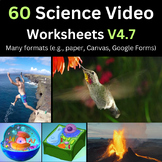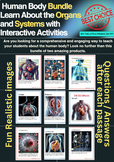32 results
Astronomy simulations for Microsoft Word

Tides Lab Using Water Balloons - Hands On Experience That Kids LOVE!
This lab is a really fun way to use discovery and investigation to teach students how gravity and inertia cause tides, along with the moon. The cost is low (a package of water balloons and yarn) and it is a great activity to get kids moving and outside. They work in small groups and go through a series of steps and procedures and record data. This was one of the most fun labs of the year for students and was instrumental is having kids understand why we have high tides on the side of the Earth c
Subjects:
Grades:
6th - 12th

Experience the Moon Phases Discovery Lab
Students create and actually see the moon phases as they change the alignment between the Earth, Moon, and Sun. You only need the following supplies (styrofoam balls, popcicle sticks or sharpened pencils, and a light without a lamp shade) as seen in the picture, along with the Lab Sheet I have created to go with this hands-on activity. Could be a 1 or 2 day activity. Answer Key included. Very easy to set up and do. My students love this-as do I. Thanks and enjoy!
Subjects:
Grades:
1st - 6th
Types:

Constellations Lab
I was about to lecture on constellations this year and realized that perhaps the students could teach themselves by using Stellarium-web.org, where they can move and manipulate the sky. I created this worksheet/guide for them to follow! It worked great and they enjoyed it. I had to give them some verbal help, but overall it was much more effective than a lecture. You will need computer access for your students, although you could do it as a demo on a smartboard but that would be less effecti
Subjects:
Grades:
7th - 12th, Higher Education, Adult Education, Staff
Types:
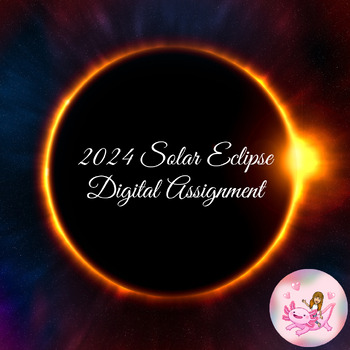
2024 Solar Eclipse Digital Assignment
This digital assignment assists students in understanding what an eclipse is and the different types of eclipses' as well as how they can happen. The assignment also cover the safety of wearing appropriate eye protection while viewing the eclipse. The reading portions of this assignment were pulled from NASA and are followed with comprehension questions to check students' knowledge on the reading. There is also an interactive link provided in which students can get a visual of the pathway the to
Subjects:
Grades:
7th - 10th
Types:
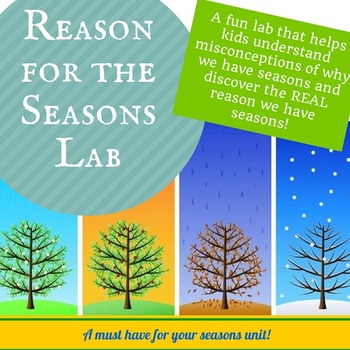
Reason for the Seasons Lab
This lab is suitable for students from grades 5-8 and addresses the following learning goals:
I can survey a group of people to collect data
I can tally data and organize by main idea
I can create a bar graph or pie chart with the data I collect
I can model how the Earth experiences seasons
I can model what would happen if the Earth did not have a tilt
I can describe how seasons in the Northern Hemisphere differ from seasons in the Southern Hemisphere through the year
Materials:
This document,
Subjects:
Grades:
5th - 8th
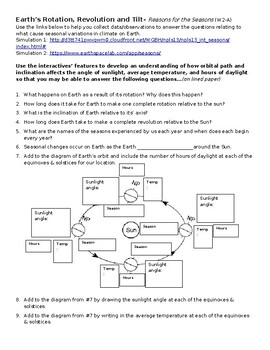
Rotation, Revolution and Reason For The Seasons
NGSS Performance Expectation:MS-ESS1-1 Develop and use a model of the Earth-sun-moon system to describe the cyclic patterns of lunar phases, eclipses of the sun and moon, and seasons.This interactive will allow students to begin to visualize what causes our seasons and what causes the time periods we experience such as days, and years. Students will look at Earth's orbital position, light angle, temperature, day length, and position of sun above the horizon to study and explain the seasonal vari
Subjects:
Grades:
6th - 8th
Types:

Universe Timeline - A brief history of 6 billion years
This activity introduces students to the major events that the majority of scientists agree occurred in the history of our universe. It extends from the formation of our solar system and ends with the evolution of humans and their migration across our planet.
Students need to identify the major events, chronologically order them, and then create a scaled timeline which lists these events. This lesson helps students visualize the major events as well as recognize trends in the order and timing
Subjects:
Grades:
7th - 10th
Types:
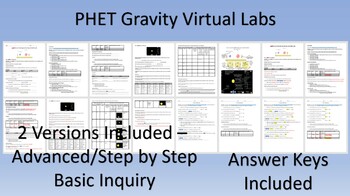
PHET Gravity and Gravity and Orbits Virtual Labs Worksheets and Answer Keys
This resource provides instructions and lab worksheets for the pHET Gravity Force Lab and Gravity and Orbits Simulations. Check out the simulations at these links if you are not familiar: Gravity Force Lab and Gravity and Orbits. The first simulation allows students to manipulate the mass of two objects and the distance between them to discover the principals of Newton's Law of Universal Gravitation (Law of Gravity). The second lab shows an application of Newton's Law of Gravity and the orbit of
Subjects:
Grades:
4th - 12th
Types:
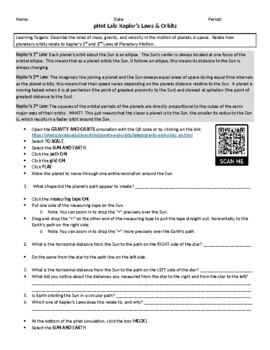
Kepler's Laws Worksheet for pHet Simulation
Students use this worksheet to guide them through an exploration of Kepler's 1st and 2nd Laws with the pHet simulation for Gravity and Obits.
Subjects:
Grades:
7th - 8th
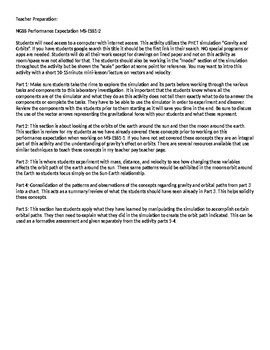
Gravity and Orbits Simulation Investigation
This resource is a way in which students can work with an online simulation/interactive through PHET and explore how/why gravity affects orbital paths. This interactive allows students to visually see how gravity impacts orbits by experimenting with factors such as mass and distance then modeling how these impact orbital paths of solar bodies. Your students will be asked to manipulate, model, and explain while participating in this activity.Covers NGSS Performance Expectation:MS-ESS1-2: Develop
Subjects:
Grades:
6th - 9th
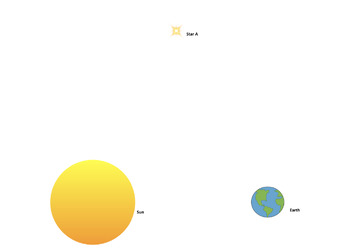
Stellar Parallax Activity - CUSTOMIZABLE
Includes 3 customizable documents. Students can work individually or in small groups to practice and apply skills real astronomers use to calculate distances between Earth and stars in space. All supplies with the exception of a ruler or straight edge are included. A simple breakdown for the math calculations is included with step-by-step instructions! The activity concludes with follow up questions. Everything can be customized!
Subjects:
Grades:
9th - 12th, Higher Education, Adult Education
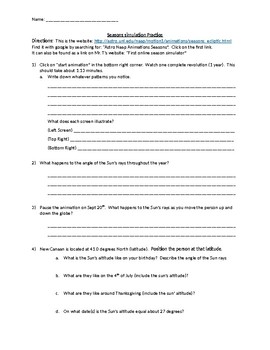
Seasons online simulator
This worksheet walks students through the following online simulator. Students explore the various screens and look for patterns that explain why seasons occur and what can be observed throughout the year.
Subjects:
Grades:
6th - 12th
Types:
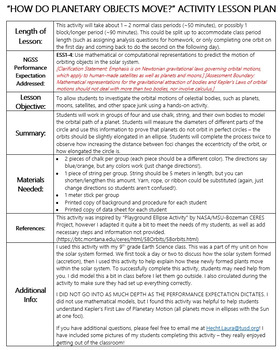
"How Do Planetary Objects Move?" - Ellipses Activity
Are you struggling with engaging your students in understanding how bodies move in our solar system? LOOK NO FURTHER!This activity is great for modeling orbits of planets, moons, and satellites. Ditch that old activity where students use pushpins and sit at their desks. This activity gets students up, outside, and actively engages students in learning! No boredom here!Students will work in groups of four and use chalk, string, and their own bodies to model the orbital path of a planet. Students
Subjects:
Grades:
7th - 11th
NGSS:
HS-ESS1-4
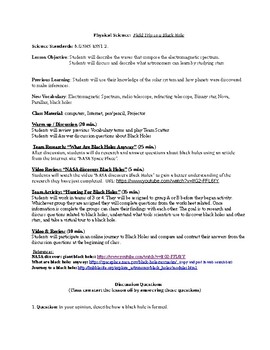
Journey to a Black Hole
Students take an incredible interactive virtual journey using NASA's space website to visit black holes and discovery the mystery behind these powerful dying stars. On their journey, students will discover and use tools used by scientist to explore the universe around them. Once they have documented their findings, students will begin a virtual journey to a black hole (Cygnus 1 or Andromeda). This product comes with a lesson plan with all the references and links to the websites that will be use
Subjects:
Grades:
4th - 12th
Types:

Simulation - Planet Exploration - A Field Trip into Space
This space unit is a simulation in which a class steps into the shoes of science specialists who create a video documentary called "A Field Trip into Space" As you can see in the preview, the students create a new identity. They will become an adult with a job in their own community. They will apply for a new job with the S.P.A.C.E. (Scientific Program for Aeronautic Cosmic Explorers) This unit will take approximately 4 weeks to complete (45 minutes – 1 hour / 2-3 days a week). This unit inc
Subjects:
Grades:
3rd - 5th
Types:
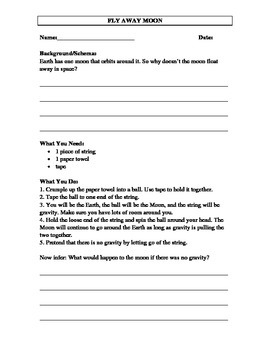
Gravity Experiment - Fly Away Moon
This is a hands-on activity/experiment to an introduction to gravity. I use this in my space unit for Science. It's only 3 materials so it's very convenient and the kids just love it. I wrote the instructions in a step-by-step format so the students can either do it independently or in groups. (I do groups of 5.) Or you can read the steps aloud and walk them through it to differentiate. There are 2 open-response questions for students to answer. I also take pictures of them doing it for the par
Subjects:
Grades:
3rd - 7th
Types:
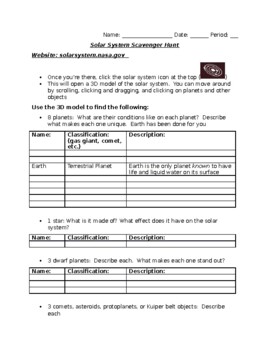
Solar System Scavenger Hunt (Digital/Online Resource)
This activity is based on the NASA website. This site has an interactive 3D model of the solar system, which students can use to explore the various planets, asteroids, comets, and other objects that orbit the sun.The activity prompts students to find the 8 planets, as well as some dwarf planets, asteroids, comets, and spacecraft, and use the information in the 3D model to describe them.
Subjects:
Grades:
9th - 12th, Higher Education, Adult Education
Types:
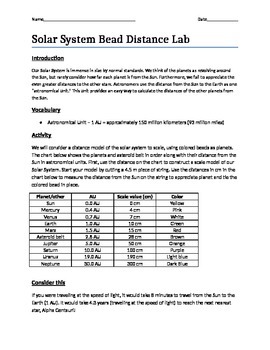
Solar System Scale Lab
Students will create a model of the solar system using a long piece of string and beads. The different color beads represent the sun, planets, and asteroid belt. The purpose of the lab is to demonstrate a scaled down version of the size of our solar system and how far away each planet is from each other.
Subjects:
Grades:
4th - 12th
Types:

Sun Trajectory as it rises and sets iPad lab
Students interact and make observations of the sun's trajectory as it rises and sets at specified dates during the year. The app is free and this is the lab sheet to ensure students are learning the material you want them to.
Subjects:
Grades:
8th - 9th
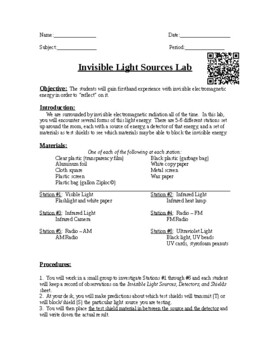
Invisible Light Sources Lab
Great lab to let students "see" other spectrums of light. Including UV, radio, Infrared, and visible. The materials list for the lab is a bit extensive, but it's worth it. Once you have it setup, it works for years. Students really enjoy the lab as it's definitely "eye-opening." Okay, I'll stop with the puns.Materials List:One of each of the following at each station: Clear plastic (transparency film) Black plastic (garbage bag) Aluminum foil White copy paper Cloth square Metal screen Plast
Subjects:
Grades:
9th - 12th
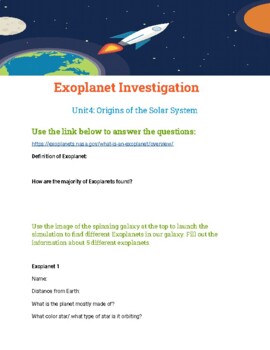
Exoplanet Investigation
Guided investigation on exoplanets in our solar system. Using an online simulation, students are analyzing and researching different types of planets that exist outside of our solar system. Basic understanding of terrestrial and jovian planets needed.
Subjects:
Grades:
8th - 12th
Types:
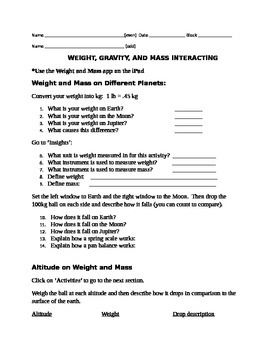
Weight, Gravity, and Mass iPad lab
This is virtual lab intended for students to learn and to understand the difference between the three as well as the interaction of weight, mass and gravity. The app is free and this is the lab sheet that students use to navigate through the app to ensure they are learning the necessary information.
Subjects:
Grades:
6th - 8th
Types:
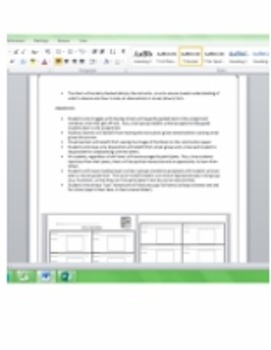
Astronomy For Inquisitive Minds!
Round up your little astronauts and fill their minds with "far out" knowledge! These 5 lessons are designed to engage all learners through hands-on activities and demonstrations.Each lesson contains a learning activity through which students "discover" information about the solar system. Student-guided learning with strong teacher support helps students truly own the knowledge they come to find!Unit Includes:*Adaptations for different learners*Pre and post assessment analysis*Five hands-on les
Subjects:
Grades:
5th - 6th
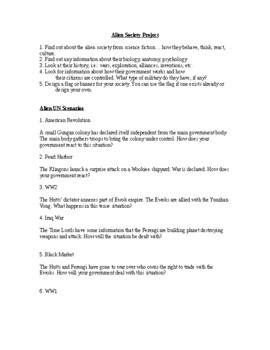
Alien Socities and UN Debate project
Have students that are interested in science fiction or aliens? Teaching history or science/biology? Why not combine the two.In this project, students will work together to research science fiction alien cultures and then come together to make a galactic UN. The teacher will then lead the class in discussions of real Earth events and students must discuss the topic and answer how their race would react to the historical event. Bonus points if they can dress up as their species.
Subjects:
Grades:
6th - 8th, Higher Education
Types:
Also included in: Life, Aliens, and Historical Events
Showing 1-24 of 32 results

